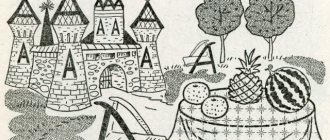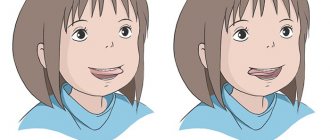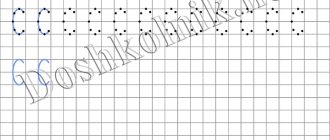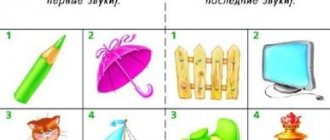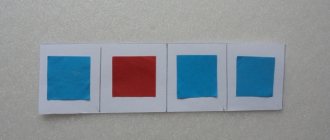Causes of pronunciation problems
The occurrence of incorrect reproduction of soft and hard
"D" is accompanied by:
- lack of correct articulation
of the speech organs; - underdevelopment of phonemic hearing (the child does not distinguish sounds from each other);
- repeating the mistakes of others;
- weak motor activity of the lower jaw and other organs of the speech apparatus (occurs with dysarthria).
Note: dysarthria is a violation of the innervation of the speech organs. The deviation appears due to damage to the central nervous system.
It is possible to establish an accurate diagnosis and cause after speech therapy
examinations.
After collecting a detailed history, the speech therapist
prescribes corrective
tasks
. Some classes should be done at home.
Correct articulation for the sounds D and D
When playing the sound “D” the speech apparatus takes the position:
The lips are completely neutral. The production depends on the subsequent vowel phoneme. The distance between the lips and incisors is about 5 mm.- The tip of the tongue rests on the upper jaw. May touch the alveoli behind the upper teeth.
- The soft part of the palate descends.
- The larynx vibrates.
- The vocal folds are closed. Presence of voiceover.
The articulation of the soft “D” differs from the hard one only in the position of the tongue. Its tip falls behind the lower incisors.
Important: Classes aimed at establishing phonemes should be conducted after the child has mastered simple vowels and consonants (a, y, o, i, e, s) and (b b, p p, mm, v v, f f).
Exercises for staging
Before you begin to master the phoneme, you should go through the preparatory stage. It consists of performing special articulation and breathing exercises (here). The child must be taught correct articulation (position of the speech organs) and breathing during the pronunciation of an isolated sound.
Articulation gymnastics
The classes are designed to train the organs involved in the pronunciation of the sounds “D” and “D” description
:
- Lower jaw. Open your mouth wide. Use your lower jaw to imitate chewing movements. Perform for 10-15 seconds.
- Lips and cheeks:
- lips are closed, and air should be drawn into the oral cavity. Next, imitate rinsing as after brushing your teeth in the morning;
- use your lips to make characteristic sounds for a horse (snorting);
- pouting lips in turn. First the top, then the bottom.
3. Language:
Exercise "Mushroom"
- "Fungus". Smile widely with your mouth open. The flat tongue is sucked to the palate. In this case, the organ should be located behind the upper incisors. Hold the position for 10-15 seconds.
- "Horse". Click your tongue on the hard palate, imitating the sound of a horse's hooves.
- "Swing". Open your mouth wide, slightly exposing your teeth. Place the tongue behind the upper and lower teeth in turn. Performed 5 times.
4.Soft palate. The baby is asked to reproduce vowel sounds. The pronunciation is soft at first, and then a hard attack is applied.
Advice: to prevent your baby from getting bored with doing the same exercises, you can use classes prescribed for speech therapists. Many options are available on the Internet.
Breathing exercises
Experts suggest performing paradoxical gymnastics according to Strelnikova. But its use is allowed for children 7-8 years old ( grade 1
). Exercises should be performed under the supervision of parents or a specialist. Initial exercises:
- Palms. The child stands up straight. He bends his arms at the elbows and shows his palms to the adult. Hands clench into fists as you inhale and unclench as you exhale. You need to breathe through your nose. Perform the exercise 4 times.
- Shoulder straps. The baby is standing upright. Hands clenched into fists. They are pressed to the belt. While inhaling, hit the floor with your fists. Gradually unclenching your hands. As you exhale, return to the starting position. Do it 4 times.
- Pump. From a level stance, make a slight forward bend. The arms are hanging at the sides. Simulate tire inflation. Lean forward and inhale. As you exhale, return to the bent position.
Important: the technique has many contraindications, so you should consult a pediatrician before performing it.
To train children's breathing, use the “tube” exercise. The lips are pulled forward. Inhale through the nasal cavity, exhale a stream of air using a formed tube. Perform 4-5 times.

